Icing
Topics available on this page:
- Ice formation
- Intensity of icing
- Effects on the aircraft
- Procedures to minimize the effects of icing
- Icing risk
- Defrost and antifreeze program in the soil
- Accidents and incidents
- Accumulation of small ice crystals in aircraft with jet engines (AGM)
Ice formation
Ice formation on aircraft is another severe weather phenomenon that can pose a threat to air operations.
The ice can accumulate on the exposed surfaces of the aircraft, increasing its weight and its resistance to the advance, causing a greater surface of contact with the air.
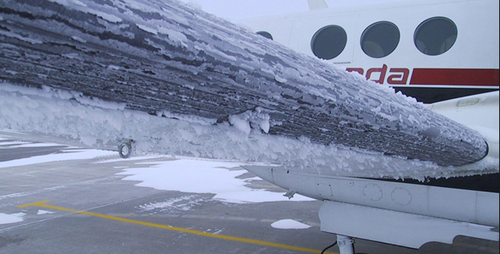
Source: Hangar 33
The formation of ice also contributes to increased fuel consumption and, consequently, to the reduction of autonomy of the aircraft, with loss of power, by the accumulation of ice in the engine of the aircraft.
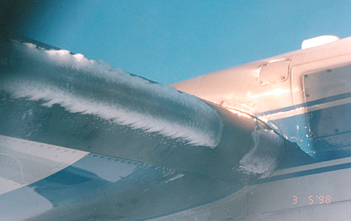
Source: https://causesdeumaviador.wordpress.com/2011/01/21/gelo-bom-na-bebida-mas-a-ferida-on-your-aircraft/
Various meteorological and aerodynamic factors contribute to the formation of ice in the structure of the aircraft. The most important are:
- Presence of liquid water;
- Temperature;
- Size of water droplets in suspension, and
- Size and speed of the object that impacts against the water drops.
The most important meteorological factor is the presence of liquid water, as the volume of ice that accumulates in the structure of an aircraft is directly proportional to the volume of water in the form of drops. When water is in the form of vapor, snow or ice crystals, there is usually no adhesion to the structure of the aircraft, greatly reducing the likelihood of ice formation.
Temperature is another important factor. Large events with ice in aircraft occur between 0 ° C and -15 ° C. When the outside air temperature is below -20 ° C, ice formation in the aircraft is now considered a rare event. Considering a standard gradient of 2 ° C loss of external air temperature every 1000ft ascent, it is noted that these conditions are usually found near the FL200. For this reason, the event is called by the aeronautical community as the freezing level or freezing level .

Note 6-1
The loss of 2 degrees at each ascent of 1,000 feet is only a benchmark for altimeter calibration. Flight planning should be based on the information contained in the wind charts and other resources available in the meteorological information service so that you can gain knowledge of the actual temperature conditions for the desired flight levels.
Another factor that also influences the formation of ice is the size and speed of the aircraft surfaces. It can be said that the thicker the impact surface, the lower the probability of ice formation.

Note 6-2
Flight at a slower speed is not indicated as a way to reduce the possibility of ice formation in the aircraft structure. Reduced speeds imply higher angles of attack, causing greater exposure of the aircraft structure, enhancing the formation of ice in this structure. Therefore, reducing cruise speed can create a favorable environment for ice formation.
It should also be noted that thinner components or surfaces accumulate ice more easily. For this reason, the leading edges of the empennage (drift and horizontal stabilizers) are more likely to accumulate ice before the accumulation occurs at the leading edges of the wings.
When accumulated in the structure of the aircraft in flight, the weight of the ice is approximately 50 pounds per cubic foot, which can reduce the maximum lift coefficient by up to 30%.

Note 6-3
As the drag coefficient has an effect contrary to the coefficient of drag, the drag coefficient becomes larger as more ice accumulates in the aircraft's airfoils, being able to double, or, in cases of greater severity, to triple the drag produced by these surfaces. In this situation, it will be necessary to apply more power to the engine to keep the flight level.
Intensity of icing
In weather forecast maps and operational messages of aeronautical interest, ice formation is classified by its accumulation ratio on the aircraft, i.e. the amount of ice formed in the time unit. By this criterion, the formation of ice can be:
Light training
At this intensity, the ice accumulation processes slowly. It is only after several minutes of flight in the clouds that some indication of it can be noticed, but not exceeding the ratio of 1 mm / min. In general, lightweight training does not affect the aircraft's operability, since the evaporation itself compensates for accumulation.
Moderate formation
The formation will be considered moderate when the accumulation is between 1 and 5 mm / min.
Strong training
The formation will be considered strong when the accumulation is between 5 and 10 mm / min. In this condition, the formation is almost instantaneous, creating a dense layer of ice on the aircraft.

Note 6-4
In extreme conditions, when usual ice-fighting systems become ineffective, ice formation may determine the immediate change of flight level.
Effects on the aircraft
When an aircraft enters an area subject to icing, some equipment may be affected by freezing.
- Carburetion system : The formation of ice in the carburetion system reduces the engine's performance and consequently its power.
- Engine Air Intake: Intake of ice by the engine can cause damage to the compressor or blades of the first stage of the engine and changes in air flow, resulting in degraded performance.
- Propellers : The accumulation of ice in the propellers reduces the performance of the aircraft. The efficiency of the propeller blades can be degraded by the accumulation of ice if this effect is not mitigated by the action of frost protection devices or if such devices are inoperative.
- Pitot Tube : If ice blocks the Pitot tube entrance or accumulates inside it, instruments that depend on the static and dynamic pressures of atmospheric air stop working, such as the climb speed indicator , altimeter, and speedometer. More details in “Final Report on the accident on 1st June 2009 to the Airbus A330-203 registered F-GZCP operated by Air France flight AF 447 Rio de Janeiro – Paris”
- Antennas : Ice accumulating on radio antennas produces detrimental effects on communications because it increases the cable diameter (film effect) and decreases the insulation of the antenna relative to the aircraft casing. As if that were not enough, the excess weight produced by the accumulation of ice could break the antenna, leaving the crew even more complicated.
- Windscreen : The accumulation of ice on the windscreen reduces visibility.
- Wings and empennage: The formation of ice that occurs in the wings and the empennage, mainly in the leading edges, modifies the aerodynamic profile, increases the resistance to the advance and diminishes the sustentation of the aircraft.

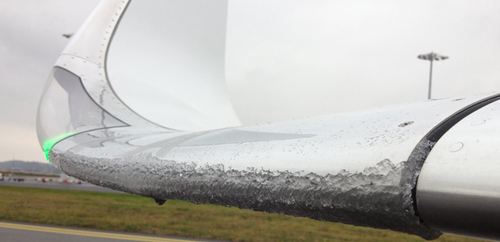
Source: Channel Piloto
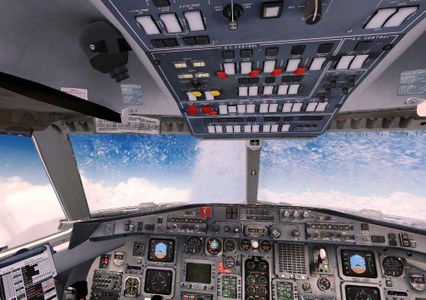
Source: http://diariodebordohofmann.blogspot.com.br/2012/08/chuva-e-gelo-em-aeronaves.html
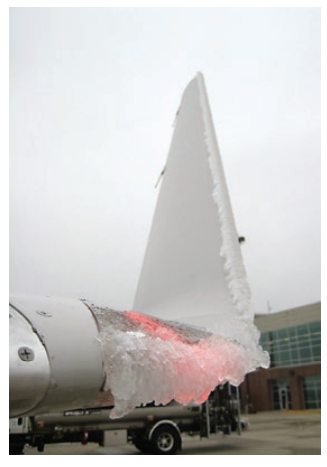
Source: bom.gov.au
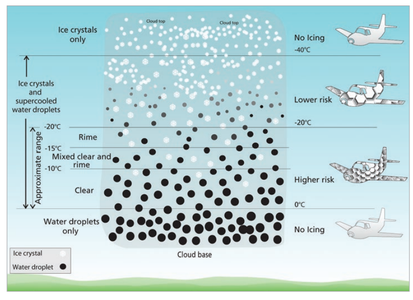
Source: bom.gov.au
Access RBAC 135
Procedures to minimize the effects of icing
The pilot must always be prepared to avoid or at least minimize the effects of ice formation on the aircraft. The following procedures should be adopted, when necessary:
- Provide removal of deposited ice on the aircraft prior to takeoff;
- Use the antifreeze system properly, following the operating rules for each type of aircraft;
- Avoid levels of flight within clouds with high precipitation index, mainly in the thermal range between 0 and -20 ° C;
- Go up to higher levels or descend to positive thermal bands (if possible), when you sense that ice-fighting systems have become inefficient, and
- Send position message, reporting ice formations on your flight level if you have been caught.

Note 6-5
When flight under ice conditions is not prohibited by the aircraft manual, there may be a guidance to the crew to alternate the destination promptly in case the accumulation of ice becomes dangerous. Consult the required actions in case of severe ice formation, published in the aircraft manufacturer's manual.

Note 6-6
Unless otherwise provided in the aircraft manufacturer's manual, it is recommended that anti-ice or de-ice systems be used as soon as ice is detected on aircraft surfaces or when ice conditions if present.
Note 6-7
During flight planning, it is important to check if temperature at cruising altitude represents a risk of precipitation freezing in the windshield or aircraft structure by checking the predicted level of ice formation en route.
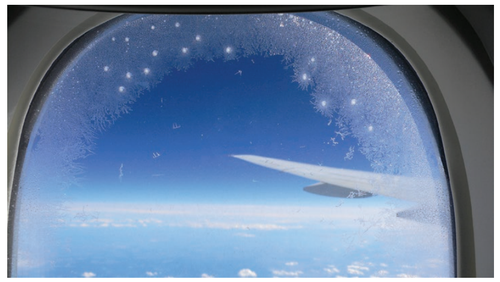
Source: Bom.gov.au
Read more about aircraft ice formation in the article Uncomplicated Aircraft Ice Formation (FGA)
Defrost and antifreeze program in the soil
Supplementary Instruction IS No. 119-005A details policies and procedures in order to standardize the application process and training programs associated with defrosting and antifreeze actions in the soil and provides a general standard of the aeronautical industry for obtaining approval of the defrost and antifreeze program in the soil.
This document provides definitions of defrost procedure, pre-takeoff check, pre-takeoff contamination check, defrost / anti-freeze check.
Defrost procedure is a procedure used to remove frost, ice, mud, or snow from an aircraft in order to provide clean surfaces.
Pre-take check is a check of the airplane's wings and other sensitive surfaces for frost, ice, or snow, within the set up time for that airplane. (RBAC 121, paragraph 121.629 (c) (4)). It can be done by observing representative surfaces through the cockpit, passenger cabin, or outside the aircraft, depending on the type of aircraft and the program approved by the ANAC.
Pre-takeoff contamination check is a check to ensure that wings, control surfaces, and other critical surfaces defined in the certificate holder's program are free of frost, frost, or snow. Such verification shall be conducted within five minutes prior to commencement of take-off, and shall be conducted outside the airplane unless otherwise approved by the approved program "(RBAC 121, para. 121.629 (c) (4)). It is sought to check that the surfaces are free of all freezing contaminants.
After-defrost / anti-frost check is a multi-part check (post defrost, before antifreeze and before pushback / taxi) after the application of the defrosting procedure to ensure that all surfaces of the aircraft are free of freezing contaminants .
The ANAC may authorize take-off with frost under the wing in the area of the fuel tanks if it can be demonstrated that there is a minimum acceptable degradation of the performance of the aircraft due to such accumulations. However, an under-wing frost that degrades the performance of the aircraft in addition to a minimum is acceptable if the appropriate performance information is provided in the Flight Manual.
Accidents and incidents
The phenomenon was mentioned in the investigation reports of the following accidents / incidents
- A - 025 / CENIPA / 2013
- I-053 / CENIPA / 2011
CENIPA reports available at http: //prevencao.po # mce_temp_url # tter.net.br/relatorio/page/1
- AT72, vicinity Manchester UK, 2016
- B738, Rostov-on-Don Russia, 2016
- B788, en-route, north of Darwin NT Australia, 2015
- A346, en route, eastern Indian Ocean, 2013
- B752, en route, western Ireland, 2013
- B752, en-route, Central Mauritania, 2010
-
A332, en-route, Atlantic Ocean, 2009 (AF 447)
-
AT43, en-route, Folgefonna Norway, 2005
- C208, Helsinki Finland, 2005
- C208, vicinity Pelee Island Canada, 2004
- F70, vicinity Munich Germany, 2004
- CVLT, en-route, Kapiti Coast New Zealand, 2003
- C172, Toronto Canada, 2003
- CL60, Birmingham UK, 2002
- C404, Kulusuk Greenland, 2002
- SH36, vicinity Marsa Brega Libya, 2000
- AT73, en-route, Roselawn IN USA, 1994
- ATP, en-route, Oxford UK, 1991
- ATP, en-route, Oxford UK, 1991
- B732, vicinity Washington National DC USA, 1982
Accumulation of small ice crystals in aircraft with jet engines (AGM)
Ice formation on aircraft is not always associated with Cumulonimbus cloud occurrence .
High concentrations of small ice crystals released at high altitudes by intense convective systems can cause accumulation of small ice crystals in aircraft with jet engines (AGM). This phenomenon presents a risk to flight safety.
These ice crystals are generally found in the ancestors of supercells and convective complexes that exhibit low radar reflectivity and temperature between -25 ° C and -70 ° C, at an altitude of 10-12 km.
See more about supercells in the "Highlights" section
When partially melted, ice crystals can adhere to the internal surfaces of aircraft engines, which are warmer, causing significant loss of power, loss of control, blackout and engine damage.
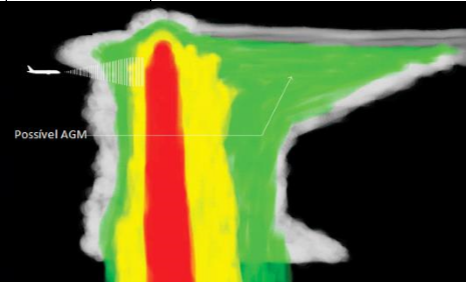
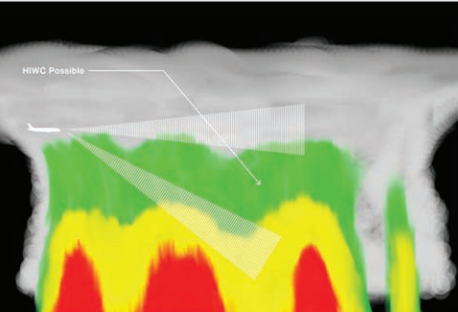
Source: Bom.gov.au
*As notas que contém itens de regulamentos brasileiros não foram traduzidas para que a interpretação delas não seja diferente da interpretação pretendida.
**Notes containing items of Brazilian regulations have not been translated so that their interpretation is not different from the intended interpretation.
Did you find errors in this content ? Send email to meteorologia@anac.gov.br to report.
